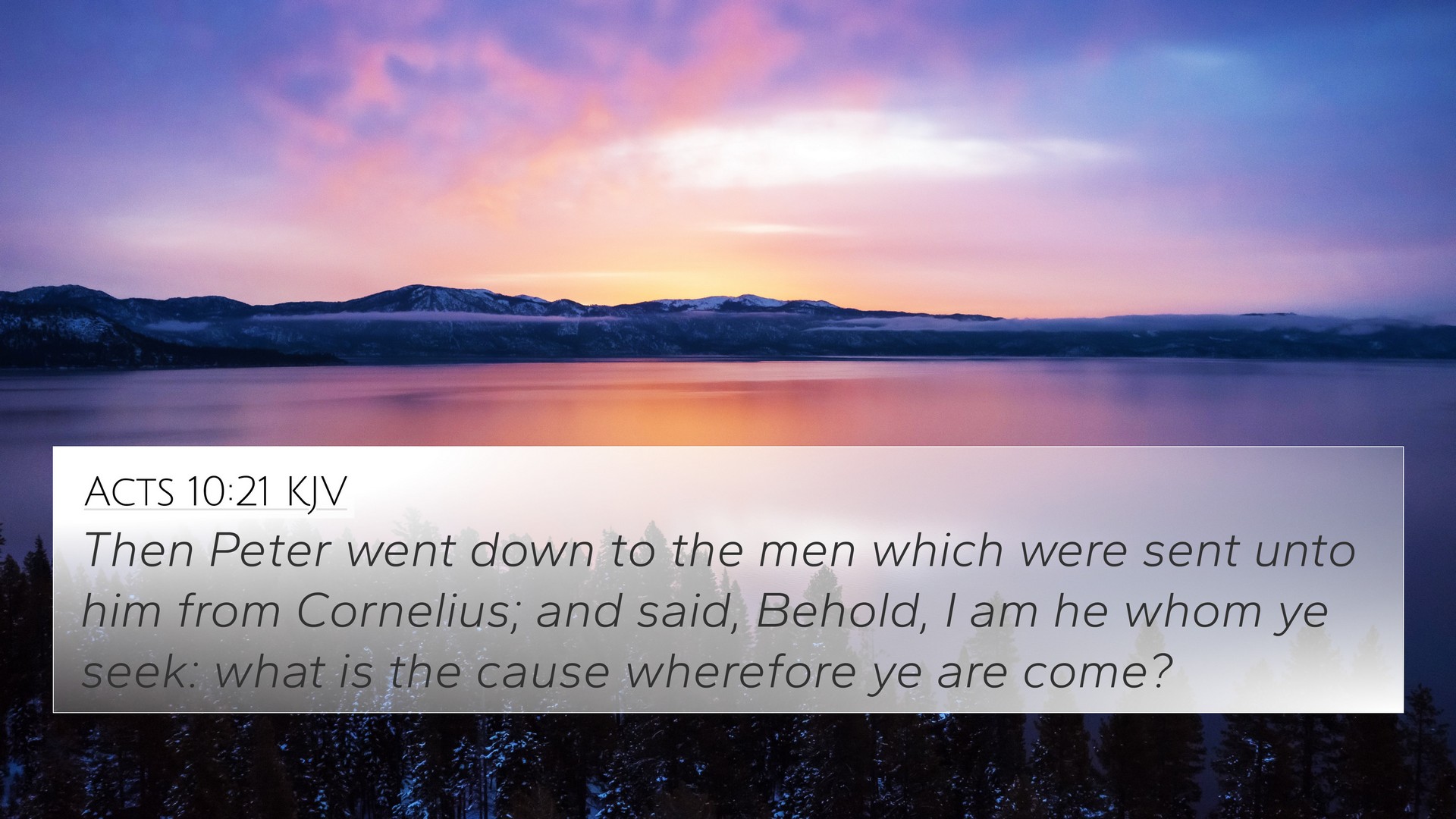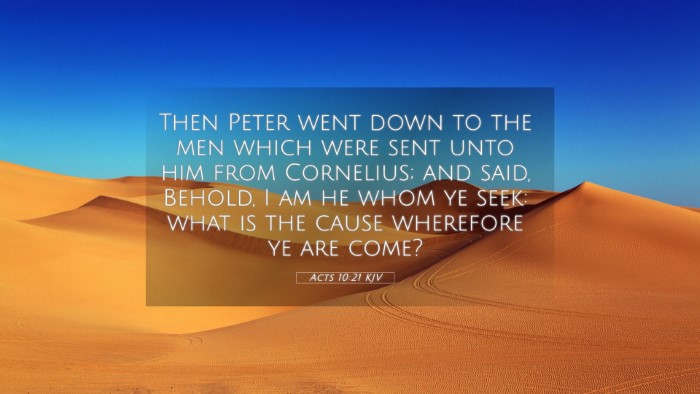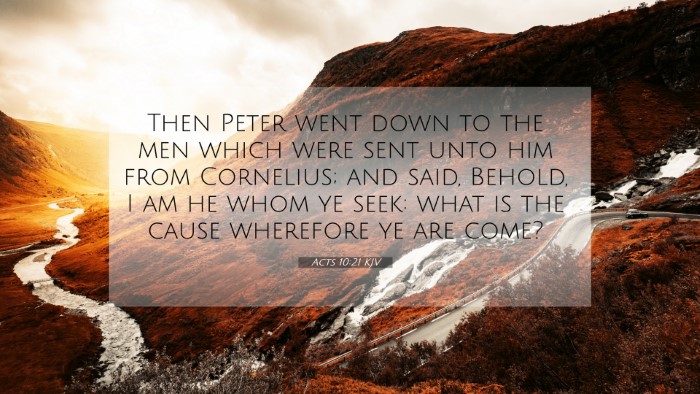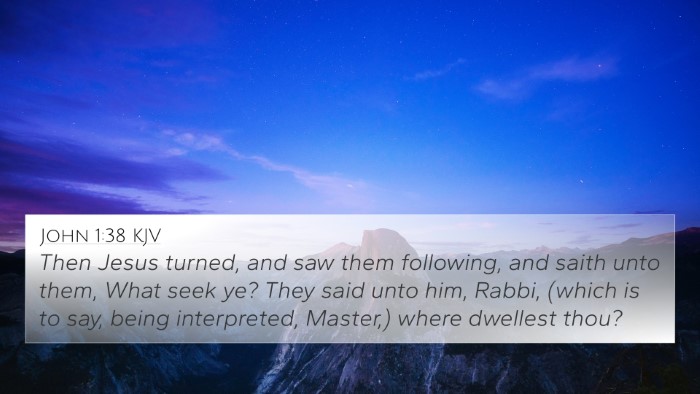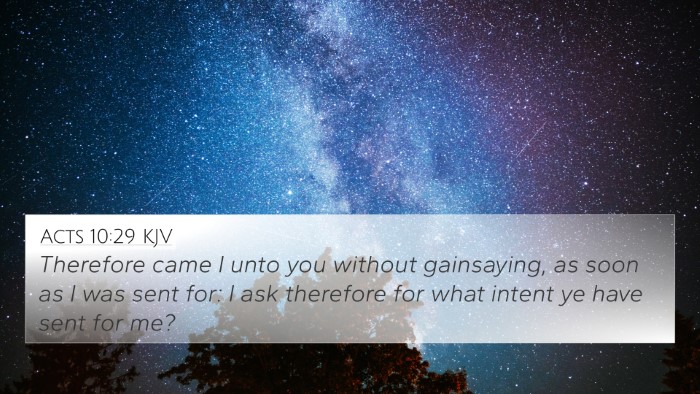Understanding Acts 10:21
Acts 10:21 states: "And Peter went down to the men which were sent unto him from Cornelius; and said, Behold, I am he whom ye seek: what is the cause wherefore ye are come?" This verse captures a moment of divine guidance, where Peter, the apostle, receives visitors sent by Cornelius, a Gentile. This encounter signifies the breaking of cultural barriers and the expansion of the Gospel beyond the Jewish community, as detailed in the narrative of the early church.
Interpretation and Insights
- Matthew Henry's Commentary: Henry emphasizes Peter's readiness to respond to God's call. His willingness to meet with Gentiles reflects the transformative power of the Gospel and illustrates God's desire for inclusivity within the church.
- Albert Barnes' Notes: Barnes discusses the significance of this meeting. He explains how Peter's acceptance of the Gentiles challenges Jewish customs and shows a pivotal moment in church history. This scripture marks a key transition in the New Testament narrative concerning the acceptance of all people into the faith.
- Adam Clarke's Commentary: Clarke elaborates on the context of this verse, mentioning that Peter is skeptical but chooses to obey. This obedience plays a crucial role in furthering God's plan, underlining trust in divine direction even amidst uncertainty.
Cross-Referencing Biblical Texts
To enrich our understanding of Acts 10:21, we can refer to several related scriptures that illustrate similar themes of divine guidance, acceptance of Gentiles, and the expansion of the early church.
- Acts 2:38-39: Here, Peter preaches repentance and the promise of the Holy Spirit to all. This illustrates the inclusive nature of the Gospel initiated at Pentecost.
- Acts 11:1-18: This recounts the initial criticism Peter faced for associating with Gentiles, highlighting the controversy and eventual acceptance of God's plan.
- Galatians 2:11-14: The confrontation between Peter and Paul over the treatment of Gentiles signifies ongoing dialogue and resolution within early Christianity regarding inclusion.
- Matthew 28:19-20: The Great Commission where Jesus commands His followers to make disciples of all nations, setting the stage for the events in Acts.
- Isaiah 49:6: A prophetic scripture hinting at God's intent for salvation to extend to the Gentiles, linking the Old Testament to New Testament fulfillments.
- Romans 10:12-15: Paul emphasizes that there is no distinction between Jew and Gentile in Christ, reinforcing the message Peter begins to preach.
- Ephesians 3:6: Paul describes the mystery of the Gospel that Gentiles are fellow heirs, linking to Peter's initial acknowledgment of this truth.
Thematic Connections
Acts 10:21 serves as a gateway to exploring key themes in Scripture such as divine calling, the breaking of cultural barriers, and the inclusivity of the Christian message. Connecting these themes through cross-referencing allows for a deeper understanding of God’s redemptive plan.
Using Cross-References for Study
For anyone looking to delve deeper, utilizing tools for bible cross-referencing can guide the exploration of how Acts 10:21 relates to the broader narrative of both the Old and New Testament.
- Bible Concordance: A concordance can help identify words and themes across different scriptures, linking Acts 10:21 to various biblical texts.
- Bible Cross-Reference Guide: Utilizing a guide will assist in understanding the contextual significance of this verse in relation to surrounding scriptures.
- Cultural Context: Understanding the Jewish-Gentile divide and how scripture addresses these differences aids in comprehending Acts 10:21.
Conclusion
Acts 10:21 not only highlights a crucial moment in early Christian history but also invites readers to explore the complexities of God's plan for humanity. By employing cross-referencing biblical texts, one can uncover the rich tapestry of narratives that support and illuminate this pivotal verse, leading to a better understanding of the theological implications for believers today.
